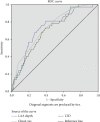Left Atrial Appendage Depth and Tachycardia Bradycardia Syndrome as Important Predictors of Left Atrial Appendage Thrombus in Patients with Nonvalvular Atrial Fibrillation
- PMID: 35401785
- PMCID: PMC8986422
- DOI: 10.1155/2022/4632823
Left Atrial Appendage Depth and Tachycardia Bradycardia Syndrome as Important Predictors of Left Atrial Appendage Thrombus in Patients with Nonvalvular Atrial Fibrillation
Retraction in
-
Retracted: Left Atrial Appendage Depth and Tachycardia Bradycardia Syndrome as Important Predictors of Left Atrial Appendage Thrombus in Patients with Nonvalvular Atrial Fibrillation.Comput Math Methods Med. 2023 Jun 28;2023:9827568. doi: 10.1155/2023/9827568. eCollection 2023. Comput Math Methods Med. 2023. PMID: 37416299 Free PMC article.
Abstract
Background: Atrial fibrillation (AF) is the most common heart rhythm disorder that has been shown to be associated with a significant increase in stroke and systemic embolism risk. The left atrial appendage (LAA) is a finger-like extension originating from the left atrium; the formation of thrombus in LAA is the main reason of stroke and systemic embolism in patients with nonvalvular atrial fibrillation (NVAF). This study is aimed at finding out the risk of left atrial appendage thrombus (LAAT) in patients with nonvalvular atrial fibrillation (NVAF).
Method: We retrospectively examined the clinic and left atrial computer tomography angiography (CTA) features of patients assessed in Zhengzhou No. 7 People's Hospital between January 2020 and January 2021 derivation. Student's t-test, chi-square test, receiver operating characteristics (ROC) curves, and logistic regression analysis were used to identify predictors of LAAT.
Result: Of 480 patients included in the analysis, LAAT was found in approximately 9.2% of all patients. Univariate demographic predictors of LAAT included left atrium top and bottom diameter (LTD), left atrial appendage depth (LAAD), CHA2DS2-VASc, tachycardia bradycardia syndrome (TBS), and nonparoxysmal atrial fibrillation (PAF). In a multiple logistic regression analysis, the independent predictors of thrombus were LAAD > 23.45 mm (odds ratio: 4.216, 95% CI: 1.869-9.510, P = 0.001), TBS (odds ratio: 4.076, 95% CI: 1.655-10.038, P = 0.002), and non-PAF (odds ratio: 2.896, 95% CI: 1.183-7.094, P = 0.02).
Conclusion: In NVAF patients with LAAT, evidence suggested that larger LAAD, non-PAF, and TBS present a high risk of LAAT. This is the first report demonstrating that the LAAD and TBS are associated with LAAT in patients with NVAF.
Copyright © 2022 Yinge He et al.
Conflict of interest statement
The authors declare that they have no conflicts of interest.
Figures
Similar articles
-
Mechanical concordance between left atrium and left atrial appendage in nonvalvular atrial fibrillation: can it be exploited to avoid transesophageal echocardiography prior to electrical cardioversion during Covid-19 pandemic?Int J Cardiovasc Imaging. 2022 Feb;38(2):351-362. doi: 10.1007/s10554-021-02414-w. Epub 2021 Sep 18. Int J Cardiovasc Imaging. 2022. PMID: 34537932 Free PMC article.
-
A nomogram to predict left atrial appendage thrombus and spontaneous echo contrast in non-valvular atrial fibrillation patients.BMC Cardiovasc Disord. 2022 Jul 12;22(1):311. doi: 10.1186/s12872-022-02737-z. BMC Cardiovasc Disord. 2022. PMID: 35820838 Free PMC article.
-
Predictive value of left atrial appendage lobes on left atrial thrombus or spontaneous echo contrast in patients with non-valvular atrial fibrillation.BMC Cardiovasc Disord. 2018 Jul 31;18(1):153. doi: 10.1186/s12872-018-0889-y. BMC Cardiovasc Disord. 2018. PMID: 30064363 Free PMC article.
-
Left Atrial Appendage Thrombosis and Oral Anticoagulants: A Meta-Analysis of Risk and Treatment Response.J Cardiovasc Dev Dis. 2022 Oct 13;9(10):351. doi: 10.3390/jcdd9100351. J Cardiovasc Dev Dis. 2022. PMID: 36286303 Free PMC article. Review.
-
Prevalence of Left Atrial Appendage Thrombus in Patients Anticoagulated With Direct Oral Anticoagulants: Systematic Review and Meta-analysis.CJC Open. 2020 Dec 24;3(5):658-665. doi: 10.1016/j.cjco.2020.12.012. eCollection 2021 May. CJC Open. 2020. PMID: 34027370 Free PMC article. Review.
Cited by
-
Finding low CHA2DS2-VASc scores unreliable? Why not give morphological and hemodynamic methods a try?Front Cardiovasc Med. 2023 Jan 4;9:1032736. doi: 10.3389/fcvm.2022.1032736. eCollection 2022. Front Cardiovasc Med. 2023. PMID: 36684565 Free PMC article. Review.
-
Retracted: Left Atrial Appendage Depth and Tachycardia Bradycardia Syndrome as Important Predictors of Left Atrial Appendage Thrombus in Patients with Nonvalvular Atrial Fibrillation.Comput Math Methods Med. 2023 Jun 28;2023:9827568. doi: 10.1155/2023/9827568. eCollection 2023. Comput Math Methods Med. 2023. PMID: 37416299 Free PMC article.
References
-
- Zateyshchikov D. A., Brovkin A. N., Chistiakov D. A., Nosikov V. V. Advanced age, low left atrial appendage velocity, and factor V promoter sequence variation as predictors of left atrial thrombosis in patients with nonvalvular atrial fibrillation. Journal of Thrombosis and Thrombolysis . 2010;30(2):192–199. doi: 10.1007/s11239-010-0440-1. - DOI - PubMed
-
- Holmes D. R., Reddy V. Y., Turi Z. G., et al. Percutaneous closure of the left atrial appendage versus warfarin therapy for prevention of stroke in patients with atrial fibrillation: a randomised non-inferiority trial. Lancet . 2009;374(9689):534–542. doi: 10.1016/S0140-6736(09)61343-X. - DOI - PubMed
Publication types
MeSH terms
LinkOut - more resources
Full Text Sources
Medical


